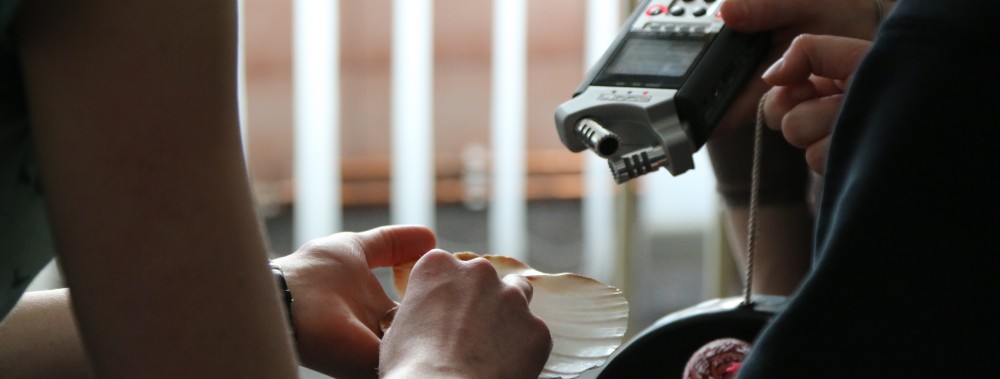Summary
Pupils work out different possibilities for the musical realisation. They should be able to engage freely in the development of their own sound compositions, whereby the individual groups may use different approaches, i.e.:
- a concrete reproduction of the listening impressions perceived at a listening station
- a sound composition, in which listening impressions of different stations are rearranged to a new sound landscape
- a new creation, based on a mix of live and digital sounds
This section deals primarily with the first two options. The focus is on making conscious decisions regarding sound qualities, forms of musical ensemble playing, forms of musical dialogue as well as interaction, as well as the creation of musical meaning with regards to the chosen topic.
- Dauer: 2 x 90 min
Key words creativity & entrepreneurship: Sensibility für problems diversity, Development for ideas and solutions, Flexibility
(The video starts with the pupil’s soundcomposition “Post – Caritas”.)
Description
Step 1: Warm-up – sound dialogue
Preparation: Pupils form pairs and sit opposite each other on chairs that are set up in a semi-circle. They have their eyes closed. Terms to describe the listening impressions of the listening walk (element 1listening walk) are written on cards (e.g. voices / conversations, bells, birds’ twittering, quick steps…).
The teacher plays an accompanying rhythm, either a continuous rhythm of their own choice or a continuous basic beat, one pupil acts as conductor.
Sequence:
- The teacher begins to play the accompanying rhythm.
- The conductor chooses a term and introduces it to the pairs.
- When the conductor touches a pair on their shoulders, they start recreating the sound with their voices or with body sounds, and they improvise a sound dialogue with their partners.
- The pairs continue until the conductor touches them on the shoulder again and they end the dialogue.
- The conductor can touch any number of pairs and thus determines the dynamics and the diversity of the sound dialogues.
When the teacher pauses, all stop the sound dialogue. When the teacher resumes the rhythm, the participating pairs continue their dialogue.
This sequence can be repeated several times with alternating conductors. Each conductor may select new sound terms.
Optionally, the sound dialogues may only focus on different qualities of conversations (schoolyard conversations, whispering in class, …);
Step 2: Introduction to sound composition
Pupils and teachers view the sound map (see description “Listening walk”) and work out possible ways of sorting the recorded listening experiences of each station, such as:
- by sound production (percussive, ringing, …)
- by sound source (human, machine, nature…)
- by moving / static sounds (flying birds, hurried steps vs. recess bell, clicking of pedestrian lights…)
Step 3: Musical characteristics of listening impressions
With the help of different terms from the sound map, the class works out the musical characteristics of the listening impressions, with reference to their
- spatial dimension, i.e. pitch, direction of movement of the sound, punctual, linear or flat sound etc.,
- temporal dimension, i.e. tempo, rhythm,
- dynamic dimension, i.e. volume, accentuation, sound colour
Example: running steps, fast tempo, p – cresc – f – decres – p, percussive, character, impulsive, pushing forward…
Together, the class try a first performance of the discussed concepts on their own instruments or on school instruments.
Step 4: Development of a sound composition
Pupils form small groups and develop their own idea of a soundscape. This can be realised in different ways. The results presented below are taken from the project:
- Pupils choose terms from the sound map and invent a short story about them
- On the basis of the previously discussed characteristics of sounds, pupils decide on the vocal / instrumental realisation of the sounds in the story
- The groups present their results in class
- All group results are now, one by one, merged into a large sound composition. The class then makes various decisions and reflects on them after each performance.
Impulses for the decision making process and the reflection:
- Who plays when?
- Who plays with whom, who plays another voice?
- Do all play at once, one after each other or at different times?
- Will instruments be switched?
- How can instruments be played differently
- Where are pauses?
- Are there repetitions?
- Are there surprising moments?…..
The process of further developing the composition may span several weeks. During this creative process, the class plays, records, reflects and changes the piece time and again until a reproducible result is obtained which is satisfactory for both pupils and the teacher.
Competencies
The pupils are able to:
- communicate verbally or acoustically with a partner without visual control.
- describe musical characteristics of listening impressions and translate them vocally / instrumentally.
- express their own musical ideas. They realise and develop them in the ensemble play with others.
- make self-responsible agreements in the group and work constructively with others.
Materials
- sound map and sound map cards
- school instruments
- pupils‘ instruments, where available
- term cards
- recording device
Module overview
|
